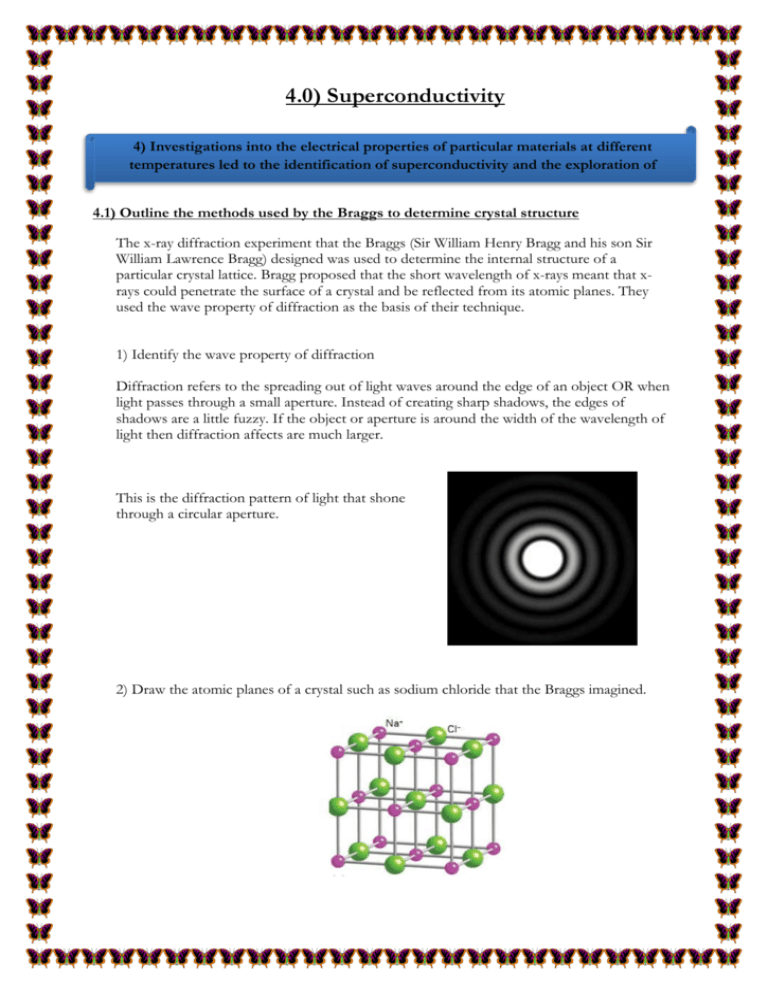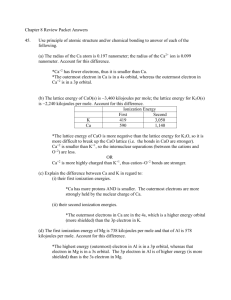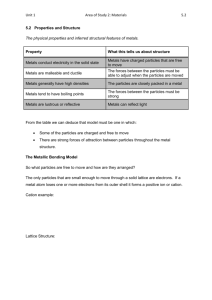4.0) Superconductivity
advertisement

4.0) Superconductivity 4) Investigations into the electrical properties of particular materials at different temperatures led to the identification of superconductivity and the exploration of possible applications 4.1) Outline the methods used by the Braggs to determine crystal structure The x-ray diffraction experiment that the Braggs (Sir William Henry Bragg and his son Sir William Lawrence Bragg) designed was used to determine the internal structure of a particular crystal lattice. Bragg proposed that the short wavelength of x-rays meant that xrays could penetrate the surface of a crystal and be reflected from its atomic planes. They used the wave property of diffraction as the basis of their technique. 1) Identify the wave property of diffraction Diffraction refers to the spreading out of light waves around the edge of an object OR when light passes through a small aperture. Instead of creating sharp shadows, the edges of shadows are a little fuzzy. If the object or aperture is around the width of the wavelength of light then diffraction affects are much larger. This is the diffraction pattern of light that shone through a circular aperture. 2) Draw the atomic planes of a crystal such as sodium chloride that the Braggs imagined. 3) Diagram of the Bragg’s Experiment and the diffraction pattern produced. 4) Outline of method of Bragg’s Experiment X-rays are aimed at a metal crystal to be studied The diffraction patterns formed from the reflected rays are photographed (as shown above) and analysed to determine the distance between the atomic layers as shown below. If constructive interference occurs between two xrays then the path difference must be equal to an integral number of wavelengths nλ= PB2 + QB2 = 2dsinθ 4.2) Identify that metals posses a crystal lattice structure The Braggs showed that metallic structure consists of a lattice of positively charged metal ions ‘floating in a sea of electrons’ i.e. metals possess a crystal lattice structure. 4.3) Describe conduction in metals as a free movement of electrons unimpeded by the lattice In a metal the valence electrons are thought of as being shared by all the positive metal ions. Therefore, the delocalized electrons are free to move throughout the crystal lattice and to conduct electricity. Metals are excellent conductors of electricity due to the presence of a large number of delocalized electrons. 4.4) Identify that resistance in metals is increased by the presence of impurities and scattering of electrons by lattice vibrations Resistance in typical metals can be increased by: i. ii. iii. iv. Increasing temperature: increases the energy of the lattice, leading to an increase in the vibration of all the particles inside the lattice. Vibration=more collisions between the electrons and the lattice, impeding their movement. Increasing impurities: impedes the electron movement by distorting the crystal lattice structure of the metal. This decreases the conductivity or increases the resistance. Also - Increasing length: the longer the conductor the higher the resistance— collisions of electrons more likely to occur. Also - Decreasing the cross-sectional area of the conductor: electrons have difficulty passing through a conductor that has a small cross-sectional area—more resistance. 4.5) Describe the occurrence in superconductors below their critical temperature of a population of electron pairs unaffected by electrical resistance Superconductivity is the phenomenon exhibited by certain metals where they will have no resistance to the flow of electricity when their temperature is cooled below a certain value (critical temperature). Below Tc: lattice effects impeding electron movement changes dramatically from impeding to assisting electron flow. Assistance comes about by an effect that pairs electrons 4.6) Discuss the BCS theory Although superconductivity was first demonstrated in 1911, the first plausible explanation was offered in 1957 by a team of three physicists, John Bardeen, Leon Cooper and Robert Schrieffer. According the classical physics, a significant amount of the resistance of a metal is due to: 1. Collisions between the free electrons and the metal’s lattice vibrations known as phonons 2. The scattering of electrons due to impurities in the metal However according to the BCS Theory lattice vibrations reduce resistance. The BCS theory is explained in the following manner. The BCS theory is named after Bardeen, Cooper and Schrieffer. As an electron travels through the lattice, it distorts the positive crystal lattice inwards due to its attraction to the electron. The electron releases some of its momentum in the form of phonons into the lattice. Phonons are packets of sound energy associated with the collective vibrations in the lattice. A second electron absorbs the phonons, pushing it forwards to create a ‘Cooper Pair”. The attractive force between the two electrons in a Cooper Pair is provided by this exchange of phonons. The formation of Cooper pairs places the electrons in the lower energy state of superconductivity Once electrons are in that state, there is an energy gap that the electrons must overcome to get out of that state. Hence the electrons are kept in the superconductivity state due to this energy gap Extension Information: Also the electrons in a pair have opposite spin so the Cooper Pairs are not constrained by the Pauli Exclusion Principle and hence there can be 106 or 107 Cooper Pairs overlapping each other and all the same superconducting energy state. These Cooper pairs seem to move through a superconductor in one large group, assisting all other pairs to move through the lattice just like a line of ice skaters who are linked arm in arm. If one strikes a bump, it is supported by all the other skaters to continue moving. 4.7) Process information to identify some of the metals, metal alloys and compounds that have been identified as exhibiting the property of superconductivity and their critical temperatures Type of Superconductor Properties Name Type I (elements) Require liquid helium Have a specific value of critical magnetic field Tungsten, W Titanium, Ti Aluminium, Al Tin, Sn Mercury, Hg Lead, Pb Type II (compounds and alloys) Require liquid helium High Temperature (ceramic compounds) Require liquid nitrogen (77K) brittle Nb-Ti alloy Niobium-titanium alloy Nb-Al –Ge Niobium-aluminium-germanium alloy YBa2Cu3O7 HgBa2Ca2Cu3O8 Critical Temperature (K) 0.02 0.53 1.20 3.73 4.12 7.22 18.0 21.0 90 133 4.8) Discuss the advantages of using superconductors and identify limitations to their use Advantages Large currents can be carried with no heat loss ie very efficient Can be used to generate large magnetic fields In large projects, SC can reduce both affects on environment and electrical costs Can reduce the size of an object such as generators Allow for increased speed for computers, since superconducting switching devices could be 10 times faster than a semiconducting switching transistor. Limitations Very expensive to set up systems using superconductors Difficult to reach and maintain the low critical temperatures as must be insulated from the surroundings. Huge cost and inconvenience. Often brittle and cannot be bent or shaped into wire Some materials required to make SC such as yittrium are very rare The manufacturing process of SC is quite expensive.







![Intro to Semiconductors and Diodes []](http://s2.studylib.net/store/data/005340797_1-9cc5e13687b40f30b11ab4990fa74479-300x300.png)